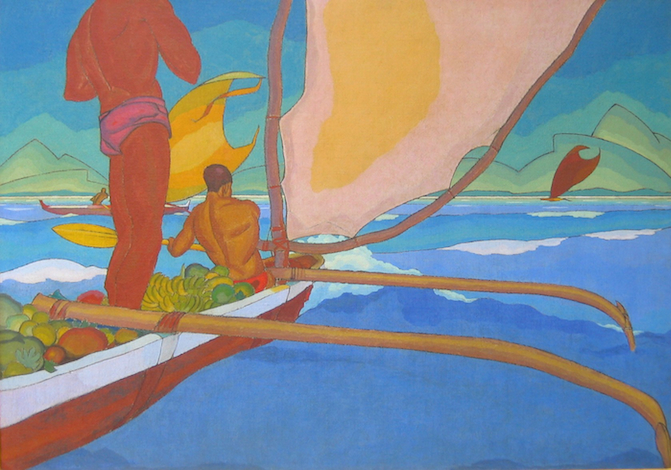This chapter of modern art’s history in Hawai‘i is largely told by non-Hawaiian artists who “fell in love” with the islands’ indigenous people, culture, and ecology.
Image above: “Men in an Outrigger Canoe Headed for Shore,” c. 1929, Arman Tateos Manookian (Armenian, born Turkey, 1904-1931), oil on canvas. Collection Drew Brown.
The Honolulu Museum of Art’s Art Deco Hawaii brings together paintings, sculptures, illustrations, prints, furniture, and housewares whose subjects and patterns were inspired by the landscape, flora, and indigenous culture of Hawai‘i. Some of these works, particularly the murals of Eugene Savage, are being shown in public for the first time since their creation.
Others, like the paintings of Madge Tennent, take on a new meaning when they are associated with those of Arman Manookian, bas-reliefs by Marguerite Blasingame, hand-carved perfume bottles by Fritz Abplanalp, and mass-produced souvenir figurines of topless Hawaiian women.
This chapter of modern art’s history in Hawai‘i is largely told by non-Hawaiian artists who “fell in love” with the islands’ indigenous people, culture, and ecology. In the intricate and exemplary depictions of flowers and mountain ranges by the likes of Juliette May Fraser and Lloyd Sexton, the landscape is unspoiled by civilization.
When Native Hawaiians are represented, as in Eugene Savage’s murals commissioned by Matson Lines, they are portrayed as carefree primitives enjoying the bounties of the land, sea, and each other. Through epic images like these, and a plethora of more humble or kitschy examples, viewers can come to recognize the roots of the persistent commercial image that Hawai‘i sells to itself and the world.
One of a set of paintings that decorated the walls of the Green Mill Grill in Honolulu in the late 1920s, Manookian’s “Men in an Outrigger Canoe Headed for Shore” presents clichés found elsewhere in the show—the sea, sky and land, and the Hawaiian native laboring casually—but Manookian pushes them into a territory of abstraction and color.
His canoe sails are stylized triangular gestures that echo a mountain range crossing the horizon like waves in profile. A thin line of distant beach sand reiterates the bold horizontals of the outrigger and the paddler’s oar. Anticipating the kinds of viewpoints that today are achieved with boom-mounted cameras and GoPros, the viewer hovers over the ocean, perspective vanishing where the canoe’s prow cuts a wave and the sail’s rigging intersects with the hull.
If it weren’t for the outrigger bearing a cargo of fruit, Manookian’s composition could easily be taken for a modern commercial image promoting a hotel resort, swimwear, waterman’s gear, or ocean conservation. Even if such a painting wasn’t meant to be a sales pitch, the show’s collection demonstrates how the global popularity of Art Deco’s stylistic conventions ultimately served commercial interests and established the framework of today’s visual culture.
Many contemporary tourist brochures, high-end magazines, and visitors’ Instagram feeds borrow from Art Deco motifs: blooming flowers; brown, muscled men paddling outrigger canoes; women in suggestive poses; and the overloaded lū‘au table.

“Hawaii’s Decisive Hour,” 1940, Eugene Savage. Collection of Matson.
The work is all heavily stylized, as that’s the underlying appeal of Art Deco’s clean lines, bold geometry, and flattened perspectives inspired by Egyptian hieroglyphics. But this stylization distorts and erases history; the success (and nostalgia) that such art welcomes is achieved at the expense of actual Hawaiian culture.
One need look no further than Eugene Savage’s “Hawaii’s Decisive Hour,” a depiction of Hawai‘i’s 1898 annexation by the United States, to appreciate the severity of this distortion. Savage’s tableau is precise in its rendition of ‘Iolani palace, the fantastic carriage one woman is riding in, and Queen Lili‘uokulani’s clear resignation. But it is far from accurate in other ways, as the moment was certainly not celebrated by throngs of hula-dancing Hawaiians in Western dress.
By bringing this array of works together, curator Theresa Papanikolas reveals the inspiration and appeal of the Art Deco movement, but the show’s historical significance is only the tip of the iceberg. Many will see this show for the aesthetics and the nostalgia associated with so many of these images. But thanks to clear and impartial wall text, visitors will also be challenged to consider how the qualities of any given work cannot be separated from the complex politics of its subject matter nor the circumstances around which it was produced.
Art Deco Hawai‘i will be on display through January 11, 2015 at the Honolulu Museum of Art, 900 Beretania St. For more information, visit honolulumuseum.org.

